|

Installation performance by:
Erik Alalooga (Estonia)
and Mai Sööt (Estonia)
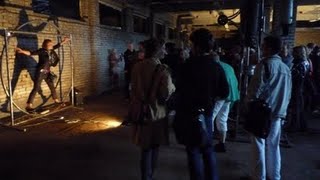
>kinematic mysterium< is working with a transdisciplinary approach to sculpture as a imaginary object raised and realized by a number of people in co-operation with the artists concidering the action of creation as the only way of perception.
Kinematic mysterium
by Erik Alalooga
Since 2005 i have been working with simpliest form of interaction between object and subject – dilaogue. During last year i have started to research more complicated form of communication, which can be called trialogue.
Trialogue is not situation where just three persons are having conversation, because in this kind of situation the schema of communication is still dialogue, which consists of subject who is speaking and object (might include more than one person) who is listening. In trialogue communication between object and subect in not possible without „help“ of third member (medium), who is not participating in communication itself.
In my first show, where i dealed with this topic, there where a persons who could launch kinematic sytem, but they were visually isolated from the final result. Person(s), whom we can call subjects, could perceive final result, but didn´t have any chance to launch all system. Object was kinetic sculpture which started to work (communicate with subject) only while „mediums“ where in action with system.
So in this show spectators were enforced to create temporary networks to revitalize the exhibition. Without it all system remained just abstract structure of materia.
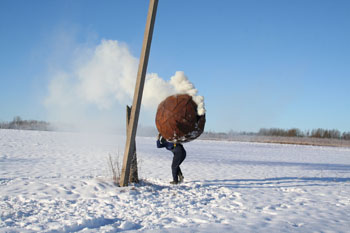
In July 2009 i continued with this topic and in big performance „Kinematic mysterium“. It needed at least 8 persons to interact with the system at the same time to vitalize it.
But there is one more important moment - instructions. Usually in exhibitions we can see texts in white A4 on the wall next to interactive artpieces which describe very precisely how spectator must act to launch the object. For me it seemed too banal and therefore i added schemas and ciphertexts which had to be resolved to get information HOW to interact with system.
In Vienna i would like to continue with my „human experiments“ in the same direction: need of temporary cooperation between spectators to interact and launch kinematic system according to solvation of ciphertexts.
4.10. – 31.10 2009 we (me and artist Mai Sööt) will be in residency in Paris in artcenter Rivoli59, where we will prepare this kind of system to perofrm in Paris and in Vienna.
contact:
Erik Alalooga
alalooga[at]gmail.com

|
 about about 

Erik Alalooga
written by Ernest Truly (NYC)
on the occasion of Technophobile which was on display at the Art Container Gallery, Culture Factory Polymer Madara in Tallinn.
Erik Alalooga is an artist and since 2006, an instructor of interdisciplinary art at the Estonian Academy of Arts. In Estonia he has a reputation for making kinetic sculpture characterized as macho, aggressive and dangerous.
One sculpture titled “Catharsobile” (2002-2009) the spectator sits inside the sculpture and activates a mechanical sequence culminating in several spears thrusting toward the face of the immobilized visibly shaken spectator. The fierceness, directness and interactivity of Alalooga’s sculptures are what first attracted me to contemporary Estonian art production.
Alalooga’s natural flare for grandeur was magnified in his opening presentation which could be classified more as a performance then a gallery speech. He donned the purple velvet university cap of the Estonian Academy of Arts, a mismatched plaid suit and bow tie giving the appearance of a mad inventor. His arm swept over the graphic clues, machines and gadgets as he explained the installation.
The installation consists of four mechanical sculptures interconnected by electrical wires. The first sculpture is a two meter diameter steel ring mounted upright. A spectator must assume the gesture of Da Vincci’s Vitruvian man by pressing all four switches mounted on the ring with hands and feet activating a series of mechanical events in the second sculpture.
When the second sculpture is activated there is the sound of a whistle and a system of motors and pullies raise a steel tank above our heads and lowers a projector which reveals the code number for a corresponding key. The person activating the switches is visually isolated from the code so another spectator must read the code.
The third station is a steel staircase mounted to the gallery wall atop of which is a red lock box. A spectator ascends the staircase and sorts through a key ring containing a hundred or so keys. Patience is required to find the key indicated by the code. The audience gazes upon him in a feeling of suspense until the key is found. The spectator unlocks the box with the key designated by the code and presses the button inside.
The final sculpture is a fountain facing the wall and is activated when the first spectator returns to the first station and presses all four switches by assuming the pose of the Vitruvian Man while, at the same time, the other spectator presses the switch contained in the lock box atop the stairs in the second station.
The two spectators pressing the switches are fixed at their positions and visually isolated from the last machine, a fountain made from steel and fiberglass. Three molded faces, resembling the artist spew water from their bodily orifices in the expressions of joy, agony and rage.
We have come to expect from this artist some explosive spectacle as conclusion to his kinetic work and may feel disappointed by the resulting anti-climax of the soft lights and gentle flow of water. We have solved the mystery of the code, worked in collective to activate the machines, to unlock their secrets and we deserve some catharsis, some sense of resolution.
But the three faces in the quiet fountain causes us only to reflect back on the process of collaboration and collective work. The product of collective work is not the product but the process, what it means for us to work together.
What makes the work important is that it goes beyond the relationship between spectator and object to the relationship between spectators to each other. What was previously a dialogue between you and the object as in “Catharsobile” now emerges as what Alalooga refers to as “trialogue.” The spectators must interact with each other in order to activate and interact fully with the objects of art
.
Since Fluxus the art world has been eroding the boundaries between artist and spectator. Contemporary art production focuses on the experience of the viewer more then the aesthetic practice of the artist. Where Fluxus actions were limited to giving specific instructions to the audience Alalooga created a scenario where the spectators seemed inspired to interact creatively with the piece beyond the original problem set up by the artist. I observed spectators performing different attitudes on the steel ring, experimenting with the sounds of the machine and finding new solutions for pressing the switches.
Where kinetic art triggers an impulse in the spectator to interact with the art, Technophobile triggers an impulse with the spectators to interact with each other. If Alalooga’s machines make us feel nervous or afraid, it is part of an experience the artist wants to share with his audience.
Alalooga explained that his sculptures evolve over time. He observes how people interact with the work in what he calls the “human experiment” He makes observations and makes modifications in the work based on real world interactions with the object.
“I love my audience;” explains Alalooga, “I don’t want to hurt them.”
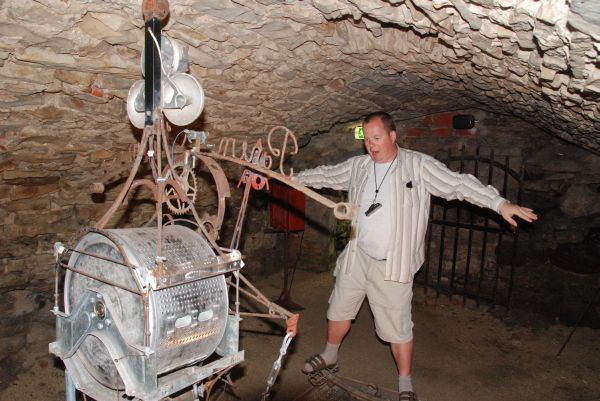
|
|
performance
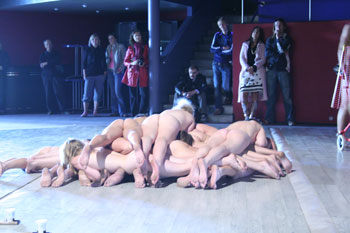
Katrin Piile, Eva Ikart, Liivi Tantaal, Regina Kuningas, Teele Altmäe, Loore Raav, Jekaterina Kultajeva, Hannes Aasamets, Kristin Orav, Ingmar Jõgi, Ralf Rammul, Carmen Lansberg, Kristi Kukk, Liina Jäger, Margus Tiitsmaa, Simon Haefele, Thomas Geiger, Erik Alalooga.
works and enacted sculpture
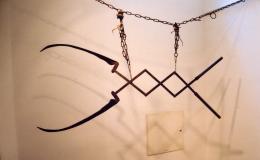
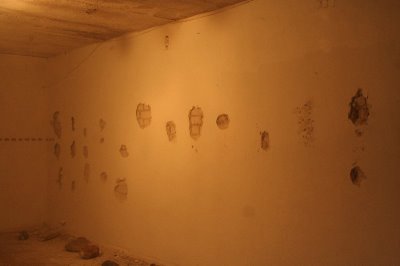
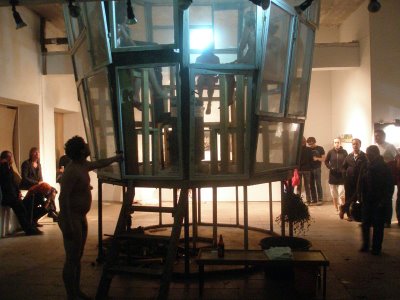
|